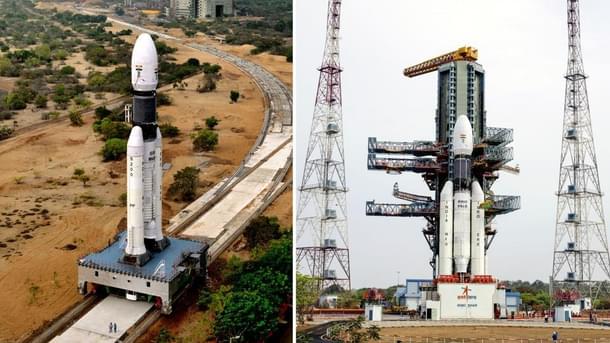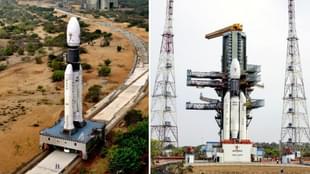Technology
Explained: Launch Of GSLV Mark-III, India’s Only Rocket Capable Of Manned Missions
Prakhar Gupta
May 17, 2018, 05:21 PM | Updated 05:21 PM IST
Save & read from anywhere!
Bookmark stories for easy access on any device or the Swarajya app.


A week from now, on 5 June, the Indian Space Research Organisation (ISRO) will launch its heaviest rocket, the 640-tonne Geo-synchronous Satellite Launch Vehicle (GSLV) Mark-III, from the Satish Dhawan Space Centre in Sriharikota. This will be the first development flight of the launch vehicle, which is reportedly 43 metres tall, has been in development for over two decades and is now ready to thrust its way out of earth’s gravity.
Although India has one of the most advanced spaces programmes on the planet and has been a space-faring nation for over 50 years, it has had to depend on others for the launch of its larger satellites to the Geosynchronous Transfer Orbit (GTO). Most recently, India used a heavy-duty rocket of Arianespace, world's first commercial launch service provider, for placing communication satellite GSAT-18 into the GTO.
India’s most capable launch vehicle until now, the GSLV Mark-II, is capable of launching payloads of only up to 2.2 tonnes into the geostationary orbit. However, the GSLV Mark-III will allow India to place satellites as heavy as 4-tonnes into the GTO. The maximum payload limit for the GSLV Mark-III is 60 per cent greater than that for the GSLV Mark-II.
Launch platforms are designed to place satellites in one of the three basic orbits, defined by their distance from the planet: Low Earth Orbit (LEO), Medium Earth Orbit (MEO) and High Earth Orbit (HEO). The higher a satellite is above the Earth’s surface, the slower it moves (as the effect of gravity decreases with increase in distance from the centre of the earth).

Satellites that are placed in the geosynchronous orbit, a HEO, move slower compared to satellites in the LEO and the MEO. This gives the satellites more time over any given area, allowing them to study the region in detail.
Also, in the geosynchronous orbit, the time taken by a satellite to complete one revolution around the Earth is equal to the period of rotation of the earth on its axis. A satellite in this orbit moves at the same speed that the Earth is turning in. Therefore, the satellite seems to stay in place over a single longitude, though it may drift from north to south. This allows a satellite in the geosynchronous orbit see a particular region of the planet almost all of the time, helping it track even the minutest developments in that area.
This particular advantage, that satellites in the geosynchronous orbit enjoy over those in other orbits, makes it attractive for both civilian and military use.
An example of this is India’s GSAT-7 or INSAT-4F, the first dedicated military communication satellite built by ISRO, launched in 2013 atop an Ariane 5 heavy-lift launch vehicle. Called Rukmini, the satellite has a nearly 2,000 nautical mile footprint over the Indian Ocean Region and provides real-time inputs to Indian Navy ships, submarine and aircraft. If successful, the GSAT Mark-III will make India self-sufficient in performing such missions, helping it develop a network of military communication satellite such as the United States’ Wideband Global SATCOM which provide US military blanket coverage over the entire planet.
On the civilian front, the advantage that the geosynchronous orbit provides has been exploited for monitoring weather, natural disasters and communication. India has launched multiple satellites for these purposes, with assistance from Arianespace in absence of am indigenous vehicle that can place heavy satellites in the GTO.
The GSLV Mark-III is also capable of lifting up to eight tonnes of payload to the Low Earth Orbit (LEO), enough to carry a manned module and establish a space station. The LEO is used for installations that space agencies are required to have frequent physical contact with, like space telescopes and space stations. Nearer the installation is to the surface of the Earth, easier it is to reach with space shuttles.
However, ISRO is unlikely to conduct a human space flight in the near future as the government has not approved the manned space programme. But given the fact that China may be the only country by 2024 to have an active space station, and that it has demonstrated a strong disregard for interests of other countries in outer space, India can’t afford to lag behind in this field for too long.
This launch is also important because the GSLV Mark-III will be India’s first fully functional rocket to be tested with the indigenously developed CE-20 cryogenic rocket engine that uses liquid propellants - liquid oxygen and liquid hydrogen. Liquid fuels are more desirable as they are less bulky than solid ones and flow better than gaseous fuels. Also, when hydrogen burns in the presence of oxygen, the exhaust velocity (velocity at which exhaust gases leave the nozzle of the rocket's engine) is 4.55 km/s. This is significantly higher than exhaust velocity of other fuels. For example, when unsymmetrical dimethylhydrazine, which fuels Polar Satellite Launch Vehicle’s Vikas engine, burns in the presence of nitrogen tetroxide, the exhaust velocity is 3.42 km/s.

Developed by ISRO’s Liquid Propulsion Systems Centre, work on the engine started when the National Democratic Alliance government approved the GSLV Mark-III project 2002. The engine was to be originally built with assistance from the former Soviet Union, but sanctions imposed by the United States on India in the later 1980s prevented Moscow from transferring cryogenic engine technology to ISRO. The result was that ISRO had to fabricate cryogenic engines indigenously.
The engine gives a thrust of about 20 tonnes, way more than its smaller cousin CE-7.5, used by ISRO to power its GSLV Mark-II rocket.
GSLV Mark-III also features two boosters on its left and right, called the S200. Boosters are large solid propellant motors used to provide thrust to the spacecraft during the initial stages of a launch. These are the third largest solid rocket propellant boosters in the world and have been developed indigenously by ISRO. The success of these boosters will be a shot in arm for ISRO as it will be a major milestone in the solid rocket motor programme of the agency.
Prakhar Gupta is a senior editor at Swarajya. He tweets @prakharkgupta.






